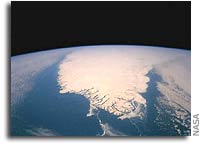NASA Flies to Greenland to Extend Polar Science

WALLOPS ISLAND, VA. — NASA scientists and crew embark this week on a month-long airborne campaign to Greenland, where they will spend more than a month making flights on an airborne science laboratory to learn about the ongoing changes to the region’s snow and ice.
Researchers led by William Krabill of NASA’s Wallops Flight Facility in Wallops Island, Va., are using NASA’s P-3B aircraft — designed for heavy lifting and low-altitude flying — outfitted with an array of science instruments. The plane is scheduled to transit March 30 from Virginia to Thule Air Base, Greenland. Weather permitting, the P-3B will make near-daily 8-hour flights over Greenland while pointing laser and radar instruments at targets until the mission’s end on May 7.
Measurements recorded by the radars and lasers will be compared and calibrated with measurements from the Ice, Cloud and land Elevation Satellite (ICESat), which makes regular, large-scale surface elevation measurements of polar ice sheets. Launched in January 2003, ICESat is already three years beyond its primary mission lifetime, so NASA scientists and engineers are making plans to bridge the anticipated gap until the launch of ICESat-II several years from now.
“It’s research like this on sea ice and the Greenland ice sheet that we use to understand how the polar regions are connected to global climate change and discover what changes are going on in atmospheric and ocean circulations,” said Tom Wagner, cryosphere program manager at NASA Headquarters in Washington, D.C. Researchers led by Krabill fly over Greenland nearly every spring to collect measurements of ice thickness. So far, flights have found evidence that, in general, ice along Greenland’s coast is thinning while some areas inland are thickening. Still, the net change points to an overall loss. There’s enough ice and snow in Greenland to raise sea level by about 7 meters (23 feet) if it were to all melt.
To determine long-term trends, scientists need sustained, highly accurate and well-calibrated measurements of ice thickness. Past and present observations combined with climate models are key to understanding the future behavior of the Greenland ice sheet.
To achieve the thickness measurements, researchers use a combination of laser and radar instruments. Laser light from the Airborne Topographic Mapper is pulsed in circular scans on the ground, which reflect back to the aircraft and are converted into elevation maps of the ice surface. Meanwhile, the Pathfinder Airborne Radar Ice Sounder instrument, to be flown on the P-3B by researchers from the Johns Hopkins University Applied Physics Laboratory, emits radio signals that penetrate and “see” all the way through the ice, measuring the elevation of the land surface below. By combining elevation data for the top and base of the ice, and taking into account the aircraft’s position using precise Global Positioning System (GPS) data, researchers can determine ice thickness at any given location.
A similar technique will be used to measure the thickness of a different target — sea ice floating on the ocean around Greenland and across the Arctic Ocean during a flight to Fairbanks, Alaska. Combining elevation data for the top of sea ice with sea level, researchers can use the known density difference between the sea and ice to estimate sea ice thickness.
Krabill and colleagues will be joined on the flights by researchers from the University of Kansas, who are flying a “snow radar” that measures how snow builds up over time on ice, how that layer becomes compacted, and how it is changing.
The P-3B will fly routes that take it directly under the path of ICESat, allowing the satellite and plane to measure the same features. Each has its benefits: the satellite provides regular, continental-scale coverage of Greenland and hard-to-reach regions like Antarctica, while the aircraft can make more detailed surveys of areas where scientists expect to see rapid change.
For more information about NASA and agency programs, visit: http://www.nasa.gov/









